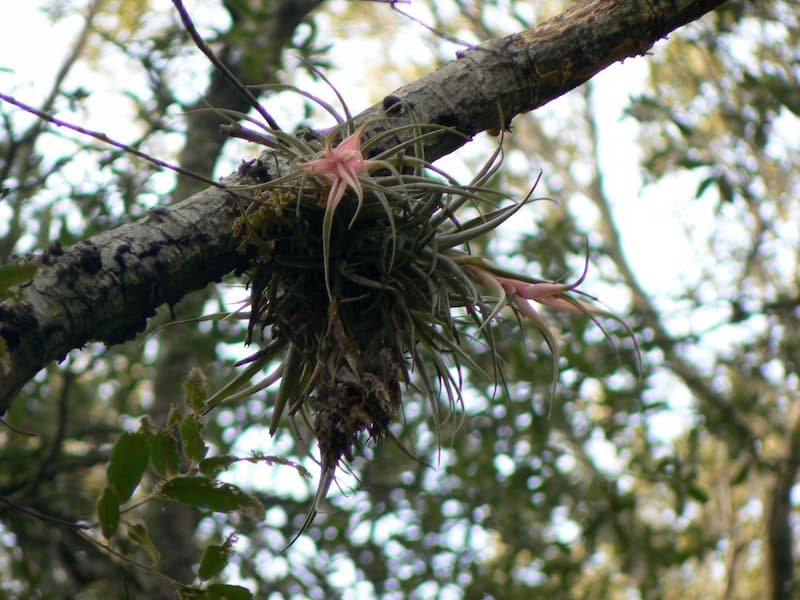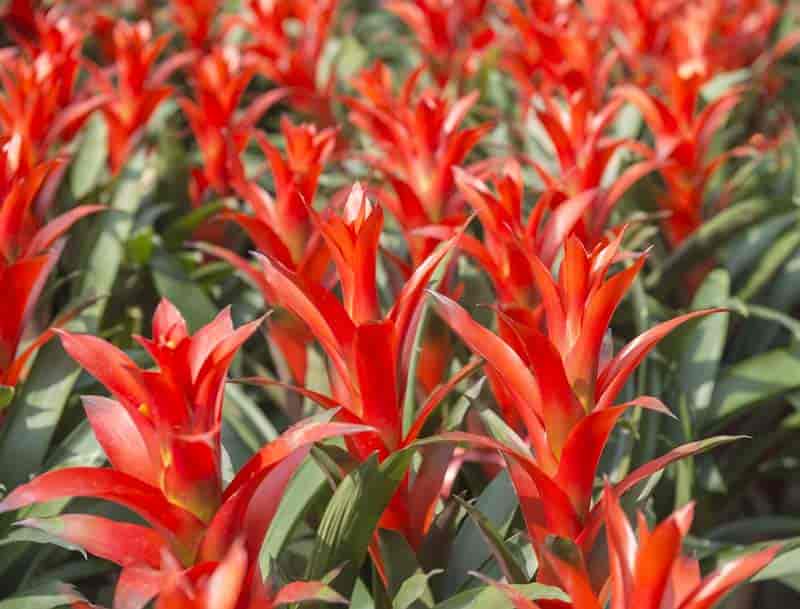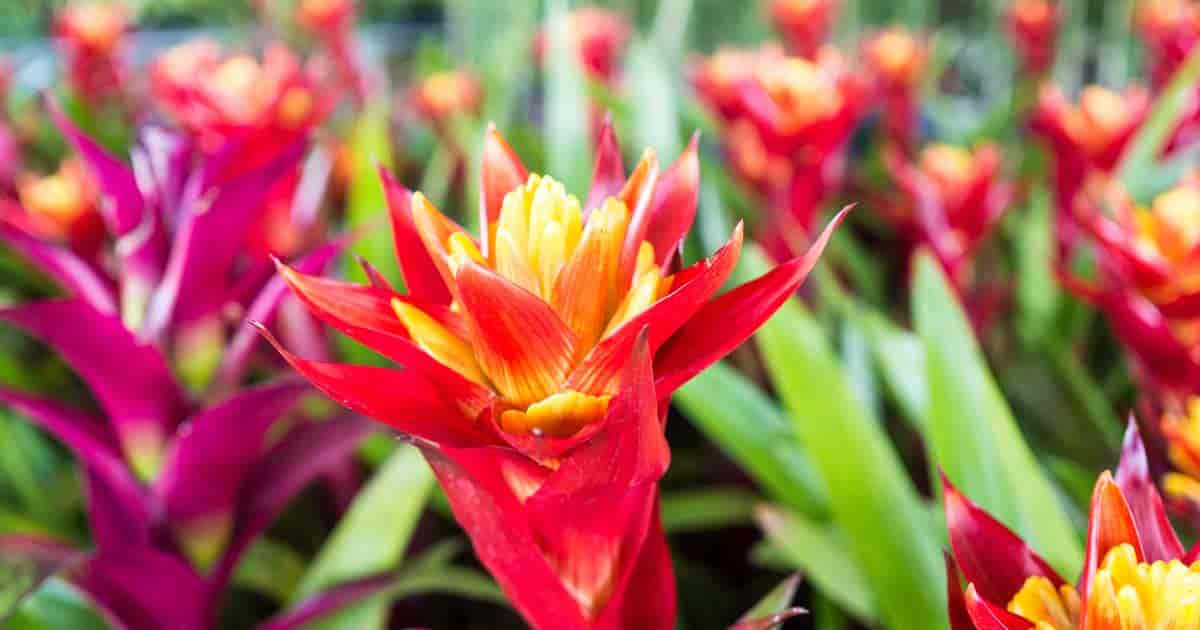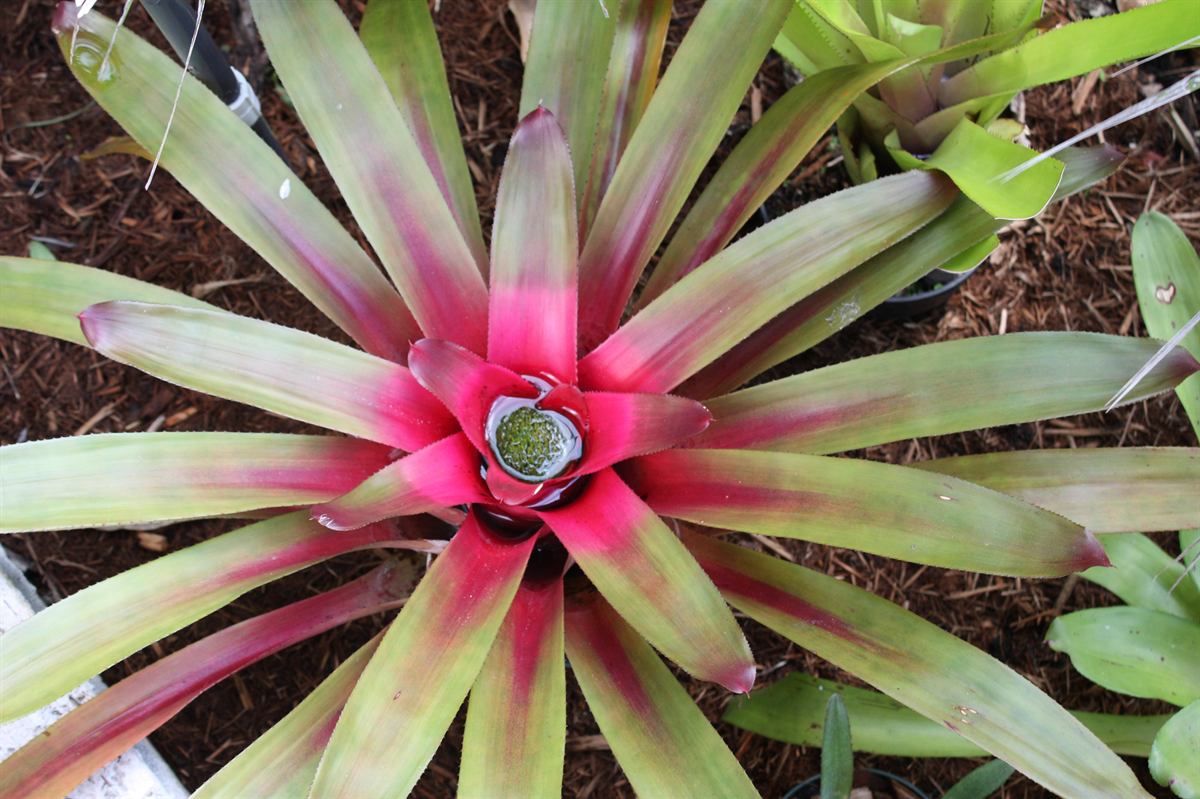Bromeliads are a diverse family of 3000 species that range in form and size from the lovely, draping Spanish moss to the 30 foot tall Puya raimondinii. Did you know that pineapple was a bromeliad? These unique and odd plants come in a wide range of colours, from basic reds, blues, and greens to dazzling gold, deep purples, and frighteningly bright tones. The foliage on these wonderful plants varies widely from species to species.
Growing bromeliads indoors brings bright colours and living greenery into your home. Some bromeliads have large, luscious, succulent leaves, whilst others have narrow, asymmetrical leaves. They are adaptable to their settings, need little care, and produce long-lasting flowers. Textures vary as well, with some leaves being soft and silky and others being spiky and harsh. The majority of bromeliads have fascinating blooms that grow from a stalk in the plant’s centre.Depending on the plant, blooms might last only a few days or can endure for years.
Quick Growing Guide
Botanical Name: Bromeliad
En français: Bromeliad
Sun / Shade:
Watering:
Soil:
Care:
Bromeliads that thrive in soil make the ideal houseplants. Billbergia, Cryptanthus, Guzmania, and Neoregelia are the four finest types for bringing inside. These are distinguished by their spikey flowers, which can be plain or have a variegated stripe.
- How Do Bromeliads Grow?
- How To Water Bromeliads
- Must Bromeliad Plants Be Kept Warm?
- Should I Fertilize My Bromeliad?
- How Much Light Does A Bromeliad Need?
- Potting and Soil For Bromeliads
- Is It Necessary To Repot Bromeliads?
- Repotting Bromeliad Babies
- How long Do Bromeliads Live?
- Are Bromeliads Toxic to Cats or Dogs?
- Create Your Own Bromeliad Garden for Year Round Colour
How Do Bromeliads Grow?
This is one aspect of Bromeliads which is absolutely fascinating. Theygrow in many places and in many ways.
- Terrestrial bromeliads which grow in the ground. Pineapples are a type of terrestrial bromeliad, and have a quite complex root system.
- Epiphytic bromeliads which grow on trees or other types of plants.
- Saxicolous variety (lichen) which grows on rocks.
Not surprisingly, in some species, roots gather water and nutrients to nourish the growing plants, like most plants.
Epiphytic bromeliads, on the other hand, absorb nutrients and moisture from the surrounding environment. This species of bromeliad includes Tillandsia usneoides, sometimes known as “air plant,” and Spanish moss. These plants’ roots cling to trees, but the plant gets its nutrients from the air and rain, not from the host tree.

Francisco Emilio Roldán Velasco, CC BY 4.0 https://creativecommons.org/licenses/by/4.0, via Wikimedia Commons
Bromeliads bloom just once. However, once mature, their “pups” will bloom, giving the “illusion” of the plant reblooming.
How To Water Bromeliads
As a houseplant, water bromeliads lightly. Use distilled water, rainwater, or pure filtered water with your bromeliads; this helps eliminate the absorption of unwanted chemicals found in some water. Generally, watering your bromeliad lightly once a week should be ample.
In the wild, they are, in a sense, self-watering. They either draw water from the air or surrounding environment or they conserve water in built-in reservoirs or rosettes many growers in a bromeliad nursery refer to as “tanks.” More on How To Water A Bromeliad Here.
Many bromeliads feature stiff, overlapping leaves. These gather and store rainwater in a reservoir for later use by the plant. Pollen, debris, and leaves from other plants fall into these reservoirs, producing an ideal habitat for single-celled organisms such as algae. This feeds a variety of organisms, including insect larvae.
A healthy bromeliad in its natural habitat develops its own little ecosystem due to its abilities to store and save water as well as supply sustenance for other species and small insects. Many species of local animals, including salamanders, tree frogs, flatworms, snails, and even small crabs, feed on and around bromeliads.
Must Bromeliad Plants Be Kept Warm?
Temperatures ranging from 60 to 80 degrees Fahrenheit are ideal for bromeliad growth (15 to 25 degrees Celsius). Some species thrive in hotter, humid environments. These frequently need a high level of atmospheric moisture. As houseplants, these kinds need misting many times a week, if not daily.
While some species flourish in colder regions, others do not. Bromeliads that thrive in cold weather require some shelter from the outdoors. Cover a cold weather bromeliad if you leave it outside in a cold climate before the temperature dips below 32 degrees Fahrenheit, or zero degrees Celsius.
Potted bromeliads used as houseplants adjust to the temperature around them. They are happy in the temperature you keep your home. When the temperature increases, increase the humidity around your plant by misting water or using a pebble plant tray. Like most plants, you should keep them away from heating and air vents so they don’t dry out.
When choosing bromeliads for your garden, carefully compare the hardiness zone to the plant description. Check out the US Department of Agriculture website for hardiness zone charts and information.
Should I Fertilize My Bromeliad?
Bromeliads are low-maintenance plants that don’t require fertilizer. Nevertheless, additional nutrition applied with a slow release fertilizer can help make the leaves more appealing and boost bloom development. You may improve their performance by giving them small feedings on a regular basis. Bromeliad plants react very well to applications of liquid water-soluble fertilizer.
Consider fertilizing your bromeliad once a month in the active growth period of spring and summer. If using a liquid fertilizer, which is most often recommended, dilute to one-quarter strength. A diluted liquid should be sprayed or gently applied around the base of the plant. Allowing liquid fertilizer to sit in your plant’s cup might cause the leaves to burn and rot.
Powder combinations, granules, or pellets, on the other hand, should be applied sparingly around the plant’s base.
Take special care not to over-fertilize. This will lead your bromeliad to grow tall and leggy, as well as dull the plant’s unique and brilliant colours.
Detailed advice is offered here on bromelaid.com

How Much Light Does A Bromeliad Need?
The quantity of light required for a bromeliad is highly dependent on the species. These plants are classified according to their leaf type, of which there are two:
- Soft, flexible leaves (particularly those of spineless plants) appreciate lower light levels. Guzmania and Vriesea bromeliad are two examples of plants that flourish in partial shade.
- Bromeliads with stiff leaves, such as Tillandsia, Aechmea, and Neoregelia, thrive in strong indirect light but should be avoided in direct sunshine. The “Silver Vase” bromeliad, Aechmea fasciata, and Aechmea blanchetiana are the most well-known Aechmeas.mea fasciata and Aechmea blanchetiana.
If you are unsure what type of leaf your plant has, watch the plant for clues in regards to lighting.
If your plant turns a very dark green, it is creating an excessive quantity of chlorophyll to compensate for the lack of light. Legginess is another sign of inadequate illumination. In addition, if your plant is growing tall and straggly.
If your plant is exposed to too much light, the leaves will become burnt or bleached. Another sign of too much light is white or brown areas on your plant’s leaves. Gradually transition from one sort of illumination to another because abrupt changes can stress the plant.
Types of Bromeliads To Add Color Around The House
To add vibrant colour to a space, combine Bromeliads of various colours in a single plant container to create a beautiful bromeliad garden. They provide a lot of colour for a long time and may really spice up a space. But which bromeliad kinds have the longest lifespan? When it comes to types to look out for, the current “best in potted bromeliads” are the Guzmania kinds, which give the greatest long lasting colour even after they’ve reached their peak. Varieties with names such as:

- Guzmania “Hilda
- Guzmania “Tutti Frutti”
- Guzmaia “Ostara”
- Guzmania “Luna”
- Guzmania “Torch”
- Guzmania ‘Marjan”
- Guzmania “Rana”

Guzmania’s lets you vary things up and obtain a decent colour rotation with all of the flower tints and colours at your disposal.
If bromeliad blooms aren’t the main attraction, but colour is, the Neoregelia family is hard to beat, especially on a sunny patio. They are durable, and the foliage provides several accent chances.

Bromels, CC BY 3.0 https://creativecommons.org/licenses/by/3.0, via Wikimedia Commons
It is simple to start a Bromeliad garden. First, use a lovely decorative container. Then mix a few of your favourite varieties. Find out when new bromeliad shipments arrive at your local nursery. Plan to buy the freshest plants, the most vibrant colours, and the best selections as soon as they arrive.
Potting and Soil For Bromeliads
All bromeliads need good drainage and steady air circulation, and acidic soil is best. Bromeliads should be grown in a barky, airy, well-draining soil. A 50-50 mix of peat moss and perlite gives good results. If you are unsure, purchase a special potting mix created just for bromeliads. This type of mix typically contains one part perlite or sand, one part peat moss and one part chopped up and decomposed pine needles or tree bark.
The plants should be potted to the base of their leaves to give the roots all available space to secure them to the soil. Bromeliad roots are often extremely tiny, and the majority of these fascinating plants may thrive in relatively small pots. With a young plant, you should start with a four-inch pot. Bromeliads should never be grown in pots greater than six inches in diameter. It is advised not to place your bromeliad in an enormous pot because doing so may lead you to overwater.
Is It Necessary To Repot Bromeliads?
There are two conditions under which you should repot bromeliads:
- A mature plant has become too large for its pot.
- Your bromeliad has created offsets that need pots of their own.
The optimum time to repot is in the spring. When potting, you must be careful not to place your plants too deeply into the dirt in any scenario. To avoid the possibility of crown rot, plant your bromeliads just to the base of the leaves. When repotting, it is critical to keep your bromeliad securely in place. If it is allowed to move, the roots will not develop properly, and the plant will be unable to establish itself. If your plant’s root system is insufficient to keep it upright, you may use some wooden stakes to assist keep it in place. Once the root system has formed, the stability stakes can be removed.
Repotting Bromeliad Babies
Little baby bromeliads are the sweetest things! Bromeliad babies, also called pups, are clones of the parent plant. Some bromeliads produce babies before flowering. However, you will frequently see them after the parent plant has bloomed and the bloom has begun to fade. If you choose, you can cut back the mother plant’s withering leaves so your puppies get a bit more light and you can see them better. Don’t be too quick to remove these offsets from the parent. They must remain stationary in order to feed off the parent plant until they reach a particular size and can thrive in their own pots.
When the babies reach one-third to one-half the size of their parent, you can remove them and repot them. It’s best to remove all of the pups at once and repot them evenly. Using a sterilized, sharp knife, detach the branch from the mother plant to extract Bromeliad pups. Repot the branch in slightly moistened bromeliad potting mix. Take extreme caution not to use too much water, since this can soon lead to rot. If everything is done correctly, your puppies will develop quickly and you may need to repot them within a half-year period.
How long Do Bromeliads Live?
If they are well cared for, bromeliads live from 2 to 5 years depending on the species. Repotting babies will give your bromeliad container and displays longevity.
Are Bromeliads Toxic to Cats or Dogs?
According to the websitePet Care Advisors, bromeliads are not harmful to your cat or dog. So breed your pet and grow bromeliads. However, cats and dogs have been known to graze on bromeliads, so it’s best for the plant to keep your kittens and puppies away from it.
Create Your Own Bromeliad Garden for Year Round Colour
Bromeliads come in a wide variety of colours and shapes, and new kinds are being found all the time. It’s easy to see how these low-maintenance plants can be a welcome addition to practically any house. While you may not have a green thumb, bromeliads are extremely likely to thrive in your garden. Because there are so many distinct sorts, ranging from Spanish moss to yucca, aloe, and even green leafy grass, you may build a diverse and intriguing collection of attractive, low-maintenance tropical bromeliads.
Whether you live in a small apartment with a few plants or a huge house with a plethora of plants, you certainly want to maintain the plants healthy and colourful. Making your own bromeliad garden is simple and straightforward. It’s a quick and inexpensive way to keep your plants healthy and colourful all year!
Take particular care of each plant. Depending on the cultivar, most Bromeliads will keep their colour for 3-6 months. If one starts to fade away, simply remove it and replace it with a new one, and you’ve got a fresh look.
Pretty simple. Go ahead. Get creative and have color all year.
You can learn much more from the Bromeliad Society.







Leave a Reply
You must be logged in to post a comment.